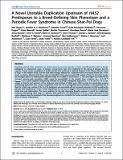Por favor, use este identificador para citar o enlazar a este item:
http://hdl.handle.net/10261/247980COMPARTIR / EXPORTAR:
 SHARE SHARE
 CORE
BASE CORE
BASE
|
|
| Visualizar otros formatos: MARC | Dublin Core | RDF | ORE | MODS | METS | DIDL | DATACITE | |

| Título: | A novel unstable duplication upstream of HAS2 predisposes to a breed-defining skin phenotype and a periodic fever syndrome in chinese shar-pei dogs |
Autor: | Olsson, Mia; Meadows, Jennifer R. S.; Truvé, Katarina; Rosengren Pielberg, Gerli; Sánchez, Armand CSIC ORCID; Lindblad-Toh, Kerstin | Fecha de publicación: | 2011 | Editor: | Public Library of Science | Citación: | PLoS Genetics 7(3): e1001332 (2011) | Resumen: | Hereditary periodic fever syndromes are characterized by recurrent episodes of fever and inflammation with no known pathogenic or autoimmune cause. In humans, several genes have been implicated in this group of diseases, but the majority of cases remain unexplained. A similar periodic fever syndrome is relatively frequent in the Chinese Shar-Pei breed of dogs. In the western world, Shar-Pei have been strongly selected for a distinctive thick and heavily folded skin. In this study, a mutation affecting both these traits was identified. Using genome-wide SNP analysis of Shar-Pei and other breeds, the strongest signal of a breed-specific selective sweep was located on chromosome 13. The same region also harbored the strongest genome-wide association (GWA) signal for susceptibility to the periodic fever syndrome (praw = 2.3×10−6, pgenome = 0.01). Dense targeted resequencing revealed two partially overlapping duplications, 14.3 Kb and 16.1 Kb in size, unique to Shar-Pei and upstream of the Hyaluronic Acid Synthase 2 (HAS2) gene. HAS2 encodes the rate-limiting enzyme synthesizing hyaluronan (HA), a major component of the skin. HA is up-regulated and accumulates in the thickened skin of Shar-Pei. A high copy number of the 16.1 Kb duplication was associated with an increased expression of HAS2 as well as the periodic fever syndrome (p<0.0001). When fragmented, HA can act as a trigger of the innate immune system and stimulate sterile fever and inflammation. The strong selection for the skin phenotype therefore appears to enrich for a pleiotropic mutation predisposing these dogs to a periodic fever syndrome. The identification of HA as a major risk factor for this canine disease raises the potential of this glycosaminoglycan as a risk factor for human periodic fevers and as an important driver of chronic inflammation. | Versión del editor: | https://doi.org/10.1371/journal.pgen.1001332 | URI: | http://hdl.handle.net/10261/247980 | DOI: | 10.1371/journal.pgen.1001332 | E-ISSN: | 1553-7404 |
| Aparece en las colecciones: | (CRAG) Artículos |
Ficheros en este ítem:
| Fichero | Descripción | Tamaño | Formato | |
|---|---|---|---|---|
| anovedog.pdf | 2,11 MB | Adobe PDF |  Visualizar/Abrir |
CORE Recommender
PubMed Central
Citations
60
checked on 04-may-2024
SCOPUSTM
Citations
113
checked on 06-may-2024
WEB OF SCIENCETM
Citations
104
checked on 26-feb-2024
Page view(s)
60
checked on 12-may-2024
Download(s)
68
checked on 12-may-2024

